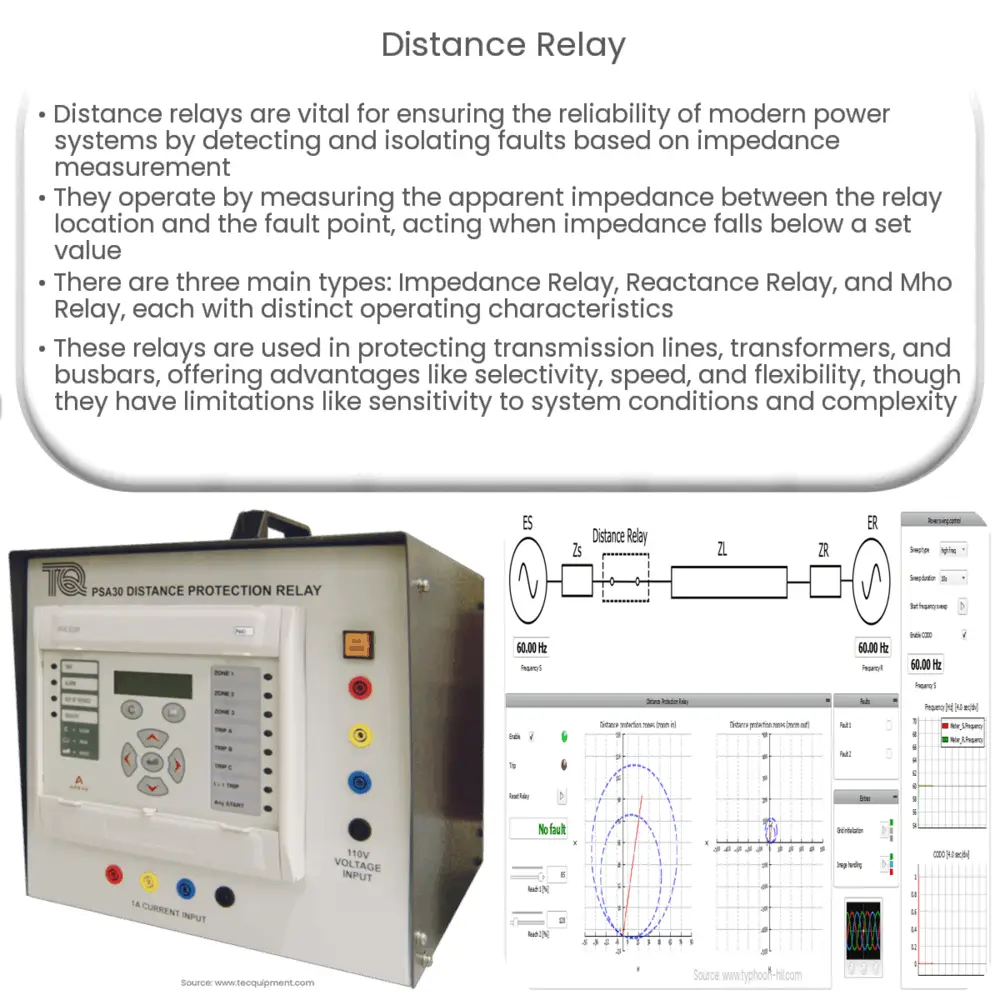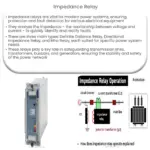Distance relays protect power systems by detecting faults based on impedance measurements, ensuring reliability and stability in electrical networks.

Understanding Distance Relay: An Essential Power System Protection Device
Introduction
Distance relays play a critical role in ensuring the reliability and stability of modern power systems. They provide selective protection to transmission lines, transformers, and other electrical equipment by detecting and isolating faults based on the impedance measurement. This article delves into the working principles, types, and applications of distance relays in power system protection.
Distance Relay Basics
Distance relays, also known as impedance relays, are a type of protective relay that measures the apparent impedance between the relay location and the point of fault in the power system. The relay operates when the measured impedance falls below a predetermined value, which corresponds to a specific distance from the relay location. This distance-based operation enables the relay to detect and clear faults selectively and efficiently.
The apparent impedance measured by the relay is typically the ratio of the voltage and current at the relay location. The voltage and current signals are obtained from the voltage and current transformers connected to the power system. By comparing the measured impedance with the pre-set values, the relay determines whether a fault exists within its zone of protection and sends a trip signal to the associated circuit breaker if necessary.
Types of Distance Relays
There are three main types of distance relays, which are differentiated by their operating characteristics and the method used to measure impedance. These are:
- Impedance Relay (Z Relay): This is the most basic type of distance relay that operates when the measured impedance falls below a predetermined value. The impedance relay is non-directional, meaning it does not discriminate between forward and reverse faults. It is primarily used for backup protection in power systems.
- Reactance Relay (X Relay): Reactance relays measure the reactance component of the impedance, which is a function of the line inductance and fault current. The reactance relay is more sensitive to changes in the fault current than the impedance relay, making it suitable for high-voltage transmission line protection.
- Mho Relay: Mho relays are the most widely used type of distance relay, providing directional and distance-based protection. They operate based on the angle between the voltage and current phasors, ensuring that the relay only operates for faults in the forward direction. Mho relays are highly reliable and suitable for the protection of long transmission lines and complex power systems.
Zone of Protection
Distance relays are designed to protect specific zones in the power system, typically defined by the distance from the relay location. These zones of protection are categorized as primary, backup, and remote backup protection zones. The primary zone provides the fastest and most selective protection, while the backup zones offer additional layers of security in case the primary protection fails or is unavailable.
Applications of Distance Relays
Distance relays are widely used in various power system protection applications, including:
- Transmission Line Protection: Distance relays are commonly employed to protect high-voltage transmission lines from faults such as short circuits, ground faults, and phase-to-phase faults. They provide selective and fast fault clearance, preventing damage to the transmission line and minimizing the impact on the power system’s stability.
- Transformer Protection: Transformers are critical components of power systems and require reliable protection schemes. Distance relays can be utilized for transformer protection by detecting faults within the transformer or on the connected lines. They can also be used as backup protection in conjunction with other transformer protection devices, such as differential relays.
- Busbar Protection: Busbars are essential for distributing power in electrical substations. Distance relays can be employed to protect busbars from faults, ensuring the continuous operation of the substation and maintaining power supply to the connected loads.
Advantages and Limitations
Distance relays offer several advantages in power system protection, such as:
- Selectivity: Distance relays can selectively clear faults within their predefined zones, minimizing the impact on the overall power system and reducing the likelihood of cascading failures.
- Speed: Distance relays operate quickly, detecting and isolating faults within milliseconds to prevent damage to electrical equipment and maintain system stability.
- Flexibility: Distance relays can be easily adapted to various power system configurations and protection requirements, making them suitable for a wide range of applications.
However, distance relays also have some limitations:
- Sensitivity to System Conditions: The performance of distance relays can be affected by changes in system conditions, such as load variation, fault resistance, and mutual coupling between parallel lines. Proper relay setting and coordination are required to overcome these challenges.
- Complexity: The design and implementation of distance relay schemes can be complex, particularly for large power systems with multiple protection zones and coordination requirements.
Conclusion
Distance relays are essential protection devices in modern power systems, providing selective and efficient fault detection and clearance. They are widely used in transmission line, transformer, and busbar protection applications. While distance relays have some limitations, their numerous advantages make them a reliable choice for power system protection. Understanding their working principles, types, and applications is crucial for power system engineers and operators to ensure the safe and reliable operation of electrical networks.



